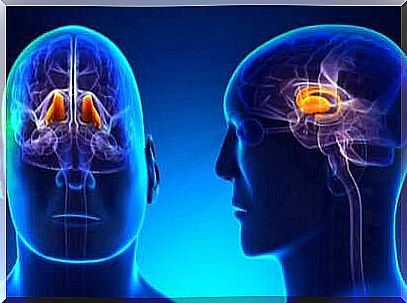How Does The Body Perceive Pain And Temperature?

Have you ever wondered why you are able to feel pain? Or how do you know when something is hot or cold? How do we humans acquire this skill that is so important to our survival? In this article we will talk about the somatosensory system, which is not only responsible for making us feel pain and temperature, but also proprioception (also known as depth sensitivity), which is the body’s awareness of our position, posture, movement, etc. .
The somatosensory system is one of the largest systems in the body. It processes sensory information (eg pain and temperature) from the body and skin. The receptors are spread throughout the body. There are two types of somatosensory systems:
- The cutaneous somatosensory system. Receptors in the skin are what make up this system. It is a peripheral system. It has kinesthetic receptors that take in information related to the body’s position and movement. The receptors are located near joints and ligaments.
- The organic somatosensory system. This system has receptors in the skeleton, muscles, and abdomen. It is an internal system.

The cutaneous somatosensory system: The key to understanding perception of pain and temperature
If you want to understand how people perceive pain and temperature, you need to understand how the cutaneous sensory receptors work. The most sensitive receptors are located on the skin and are able to generate the feeling of pain.
The skin is the body’s largest organ. Thus, it is also the largest sensory receptor. There are many sensory receptors grouped together in different ways throughout the body. They determine how sensitive you are to stimuli and all four emotions you perceive through the skin: pressure, vibration (touch), pain and temperature.
Is body hair relevant?
There is a difference between skin with hair and skin without years. Most of the skin on your body is covered with hair. The areas of the skin that do not have hair actually have more receptors, which makes them more sensitive.
The most sensitive sensory organs are the lips, the external genitalia, and the fingertips. These body parts have the highest density of sensory receptors.
Although there are no definitive studies that have proven this to be true, researchers believe that skin with hair is more sensitive to vibration and touch because both of these cause hair to move.
Pain and temperature: What type of sensory receptors are in the skin?
Cutaneous receptors can be divided into two categories: free nerve endings and encapsulated nerve endings.
Free nerve endings (FNE) are nerve fibers that end at the skin. They are probably the simplest sensory receptors. They are found everywhere in the skin and are most sensitive to perceiving pain. Although they may also perceive other sensations, perceiving pain is their specialty.
The transduction mechanism of FNE occurs when a specific part of them extends, allowing the sodium channels to open. This leads to membrane depolarization, which creates a potential for action. Contraction can trigger transduction in cold temperatures and expansion in hot temperatures.
Pain and temperature: Encapsulated receptors
Encapsulated receptors are a kind of cutaneous sensory receptor. Their name is self-explanatory: they are called encapsulated receptors because they are covered by a capsule. Some researchers divide them into four types, others into five. They classify the receptors as follows:
Pacinic corpuscles: Sensitive to pressure and touch
These receptors are found mainly in skin without hair, although there are also some in skin with hair. They are closely grouped in the lips, mammary glands, and external genitalia. Pacinic corpuscles are particularly sensitive to pressure and vibration, and less sensitive to pain and temperature.
Ruffini corpuscles
These are small encapsulated receptors. Their nerve endings are similar to free nerve endings, except that connective tissue surrounds them. They are in skin with hair, and they respond to low frequency vibrations.
Meissner corpuscles
These receptors are designed to perceive a gentle touch. They are found in skin without hair, and are located especially in the papillary dermis.
Krause endebulbus
Krause end bulbus is found exclusively in the border between the mucous membrane and dry skin. Their fibers are not myelinated and they are extremely sensitive to pressure. They have the lowest pressure threshold in the whole body.
Label plates (Label discs)
Merkel plates are also located in the papillary dermis. They are receptors that adapt slowly and only respond to a continued change in stimulus, such as a change in temperature.
Perception of pain
Your body has an adaptive warning system that allows it to perceive pain and temperature. This helps you avoid things that can hurt you, although emotional, psychological and social factors also affect feelings of pain. Things like drugs, placebo and hypnosis can also affect our perception of pain.
Thus, pain is a very subjective feeling. This suggests that there must be neuronal mechanisms that modify or disrupt pain transmission, and it does not depend only on cutaneous sensory receptors.
There are two types of pain:
- Avoidable pain. The best way to respond is to withdraw from the source of the pain.
- Inevitable pain exists at a peripheral and central level. As the name implies, it is the type of pain you can not withdraw from.
Regarding unavoidable pain, researchers have observed that there is molecular information related to the pain. When you feel the pain, the damaged cells release histamine and prostaglandins. Histamine causes the cells’ pain threshold to fall. Prostaglandins make the damaged cells more sensitive to histamine, which affects the pain threshold even more. This type of pain involves damaged tissue. There are drugs that block the histamines (antihistamines) and prostaglandins (acetylsalicylic acid, also known as Aspirin).
Can you block pain?
Studies point to the thalamus when looking at centralized pain. Although the pain is adaptable, it can affect our behavior if it is very intense. This can work against its purpose, and some people wonder if it is possible to avoid pain completely. Can one somehow block the thalamus?
Usually we call pain suppression analgesia or pain relief. Emotional and physical factors affect the process. Someone who has been a victim of stroke notices that their damage or blockage of the ventral posterior nucleus of the thalamus tends to coincide with the loss of the cutaneous sensation. In other words, they lose superficial sensations such as touch and pain.
Similarly, damage to the intralaminar nuclei blocks deep pain, but does not affect cutaneous emotions. Dorsomedial nuclei are attached to the limbic system and tend to disrupt the emotional components involved in pain.

Perception of temperature
Our perception of temperature is relative because humans do not have sensory receptors that give us absolute information about temperature. You are only able to detect sudden temperature changes, such as if you move your hand from very cold water to very hot water.
There are two types of receptors, one for cold and the other for heat. They are heterogeneously distributed throughout the skin. Cold receptors are closer to the epidermis, while heat receivers are located in a deeper zone. They are the same type of receptors; the difference is their location.
The deformation of the membrane or taps due to enlargement or contraction of the skin is what causes transduction. This deformation opens the membrane and the sodium channels. If the receptors are too close together, you will feel the heat more intensely. The nuclei in the thalamus that make it difficult to perceive cold or heat are the intralaminar nuclei and the ventricular nuclei.
It is therefore interesting that our perception of pain and temperature comes from small receptors in the skin, along with the participation of the thalamus.
All in all, it seems that all these functions have evolved to ensure human survival.









